Hey there, foodies and cooking enthusiasts! Today, I’ve got a treat for you that will take your culinary skills to a whole new level. We’re going to embark on a gastronomic adventure and master the art of making a scrumptious Beef Wellington. This classic dish has been gracing dinner tables for generations and is a true indulgence for any special occasion. So, put on your aprons, sharpen those knives, and let’s get cooking!
[ez-toc]
History
Before we dive into the cooking process, let’s take a moment to appreciate the rich history behind this exquisite dish. Beef Wellington has a fascinating origin that dates back to early 19th-century England.
Legend has it that the dish was named after Arthur Wellesley, the 1st Duke of Wellington and a renowned British military hero who defeated Napoleon at the Battle of Waterloo in 1815. It is believed that the dish was created to honor his triumph, and its name was coined by French chefs who admired the Duke.
The original concept of Beef Wellington, however, draws inspiration from another French delicacy known as “filet de boeuf en croute,” which translates to “beef fillet in pastry.” The French dish involved wrapping a beef fillet in a puff pastry and baking it until golden brown, creating a succulent and elegant centerpiece for banquets.
As Beef Wellington gained popularity in England, it underwent various transformations and adaptations. Initially, it was made using a whole beef fillet coated with liver pâté, mushroom duxelles, and savory spices. The entire package was then encased in puff pastry and baked to perfection, resulting in a delectable combination of flavors and textures.
Over the years, chefs and home cooks have experimented with the recipe, introducing their own unique twists and variations. Today, Beef Wellington has become a symbol of fine dining and is often reserved for special occasions, such as weddings, Christmas feasts, and celebratory gatherings.
The dish’s enduring appeal lies in its ability to elevate humble ingredients into a masterpiece fit for royalty. Now that we’ve delved into its captivating history, let’s proceed to the heart of the matter – the ingredients and steps to create your very own Beef Wellington masterpiece.
Time
| Step | Time (approx.) |
|---|---|
| Preparing the Beef Tenderloin | 20 minutes |
| Making the Mushroom Duxelles | 15 minutes |
| Sealing the Beef with Duxelles | 10 minutes |
| Wrapping the Beef in Puff Pastry | 10 minutes |
| Chilling the Beef Wellington | 30 minutes |
| Preheating the Oven | 10 minutes |
| Baking the Beef Wellington | 35 minutes |
| Resting the Beef Wellington | 15 minutes |
| Making the Red Wine Sauce | 20 minutes |
| Slicing and Serving the Beef Wellington | 10 minutes |
| Total Time | 2 hours |
Note: The times mentioned above are approximate and may vary based on individual cooking skills and kitchen setup.
Ingredients
| Main Ingredients | Additional Ingredients |
|---|---|
| 1 lb Beef Tenderloin | 1 tablespoon Olive Oil |
| 6 oz Mushrooms | 2 tablespoons Butter |
| 4 slices Prosciutto or Parma Ham | 1 Garlic Clove (minced) |
| 1 sheet Puff Pastry | 1 Egg (beaten, for egg wash) |
| Dijon Mustard | Salt and Pepper to taste |
Note: The quantities mentioned above are for a serving size of two people. Adjust the ingredients accordingly if you plan to prepare more servings.
Directions
Step 1: Selecting the Finest Beef Tenderloin
Before we dive into the cooking process, it’s essential to start with high-quality beef tenderloin. Head to your trusted butcher or local market and choose a well-marbled, center-cut piece. The marbling will add a layer of rich flavor and tenderness to your Beef Wellington.
Step 2: Seasoning the Beef Tenderloin
Pat the beef tenderloin dry with paper towels. Season it generously with salt and pepper, ensuring every side is coated with the seasoning. This will enhance the natural taste of the beef and elevate the overall flavor of the dish.
Step 3: Searing the Beef Tenderloin
In a hot skillet or frying pan, add a tablespoon of olive oil. Once the oil is heated, carefully place the seasoned beef tenderloin in the pan. Sear the beef on all sides until it forms a beautiful golden-brown crust. This step locks in the juices and adds a delicious caramelized taste to the final dish.
Making the Mouthwatering Mushroom Duxelles
Next up, we’ll create the delightful mushroom duxelles that will envelop the beef tenderloin, infusing it with earthy goodness.
Step 4: Preparing the Mushrooms
Clean the mushrooms using a damp cloth to remove any dirt. Finely chop the mushrooms or use a food processor to create a coarse paste. The finer the chop, the smoother the duxelles will be.
Step 5: Sautéing the Mushrooms
In a separate pan, melt two tablespoons of butter over medium heat. Add the minced garlic and sauté for a minute until fragrant. Then, add the chopped mushrooms and cook them until they release their moisture and turn golden brown. Season the duxelles with salt and pepper to taste.
Step 6: Assembling the Beef Wellington
Now comes the exciting part – assembling all the elements to create the iconic Beef Wellington.
Step 7: Coating the Beef with Dijon Mustard
Brush a thin layer of Dijon mustard over the seared beef tenderloin. The mustard acts as a flavor enhancer and helps the duxelles stick to the beef.
Step 8: Wrapping the Beef with Prosciutto
Lay the prosciutto or Parma ham slices on a clean surface, slightly overlapping them. Place the mustard-coated beef tenderloin in the center and roll the prosciutto around it, ensuring the beef is entirely enveloped. The prosciutto adds a hint of saltiness and protects the pastry from getting soggy.
Step 9: Enveloping with Puff Pastry
Roll out the puff pastry sheet on a floured surface to a size that can wrap the beef tenderloin completely. Carefully place the prosciutto-wrapped beef in the center and fold the pastry over, sealing the edges. Trim off any excess pastry and crimp the edges to create a tight seal.
Step 10: Egg Wash and Chilling
Preheat your oven to 400°F (200°C). Beat an egg and brush it over the surface of the pastry to give it a beautiful golden-brown color when baked. Place the Beef Wellington on a baking sheet and refrigerate it for about 30 minutes to firm up the pastry.
Step 11: Baking to Perfection
Once the chilling time is up, take the Beef Wellington out of the refrigerator and make a small slit in the top of the pastry to allow steam to escape. Bake it in the preheated oven for approximately 30-35 minutes or until the pastry turns golden-brown and crispy.
Step 12: Resting and Serving
Remove the Beef Wellington from the oven and let it rest for about 10-15 minutes before slicing. This allows the juices to redistribute within the beef, resulting in a tender and succulent texture. Serve the Beef Wellington in thick slices, revealing the perfectly cooked beef, rich duxelles, and buttery puff pastry.
Now, bask in the glory of your culinary masterpiece and enjoy the heavenly flavors of this timeless classic! It’s time to impress your guests or savor it with your loved one on a special occasion. Cheers to your culinary prowess!
Equipment Required
Nutrition Information
| Nutrient | Amount per Serving (2-Person) |
|---|---|
| Serving Size | 1 slice of Beef Wellington |
| Calories | 550 kcal |
| Total Fat | 35g |
| Saturated Fat | 15g |
| Trans Fat | 0g |
| Cholesterol | 120mg |
| Sodium | 550mg |
| Total Carbohydrates | 30g |
| Dietary Fiber | 2g |
| Sugars | 1g |
| Protein | 28g |
Note: The nutrition information provided above is an estimate based on the main ingredients used in the Beef Wellington recipe. The values may vary depending on specific brands and quantities of ingredients used. Be mindful of portion sizes to manage your calorie and nutrient intake effectively.
Tips
- Temperature Matters: Ensure the beef tenderloin is at room temperature before cooking. This helps it cook more evenly, preventing overcooking the exterior while the interior is undercooked.
- Puff Pastry Prep: Roll out the puff pastry sheet to the right thickness – not too thick to overwhelm the filling, and not too thin to risk tearing during assembly.
- Keep It Dry: Pat the beef tenderloin dry before seasoning and searing to achieve a beautiful crust and avoid excess moisture in the duxelles.
- Chop Mushrooms Evenly: For a smooth and even duxelles, chop the mushrooms uniformly. A food processor can make this task easier and quicker.
- Mustard Layer: A thin layer of Dijon mustard adds a delightful tang and helps the duxelles adhere to the beef. Be sure not to overdo it, as it can overpower the other flavors.
- Resting Time: Allow the Beef Wellington to rest after baking before slicing. This step ensures that the juices redistribute throughout the beef, resulting in a tender and juicy interior.
- Perfect Timing: Keep a close eye on the baking time to avoid overcooking. The ideal Beef Wellington is medium-rare, so aim for an internal temperature of around 130°F (54°C).
- Accompaniments: Serve the Beef Wellington with a rich red wine sauce, gravy, or a side of creamy mashed potatoes for a complete and satisfying meal.
Pros & Cons
| Pros | Cons |
|---|---|
| ✅ Delectable and Elegant Dish | ❌ Time-Consuming Preparation |
| ✅ Impressive Presentation | ❌ Requires Some Culinary Skill |
| ✅ Bursting with Rich Flavors | ❌ High in Calories and Fat |
| ✅ Ideal for Special Occasions | ❌ Costly with Premium Ingredients |
| ✅ Versatile for Creative Twists | ❌ Limited Shelf Life |
Conclusion
In conclusion, Beef Wellington is a culinary masterpiece that deserves a spot on your must-try list. This classic dish, with its rich history and elegant presentation, promises to take your taste buds on an unforgettable journey. From the succulent beef tenderloin, enveloped in a savory mushroom duxelles, to the flaky and buttery puff pastry, each bite is a symphony of flavors that will leave you wanting more.
While preparing Beef Wellington may require some time and effort, the end result is well worth it. This delightful dish is sure to impress your guests and make any special occasion truly memorable. Plus, its versatility allows for endless creative twists, ensuring that you can personalize the recipe to suit your preferences.
So, don your aprons, gather your ingredients, and embark on this culinary adventure. Whether you’re a seasoned cook or a novice in the kitchen, Beef Wellington offers an opportunity to showcase your skills and create a truly indulgent masterpiece.
From romantic dinners for two to grand celebrations, Beef Wellington is the ultimate show-stopping centerpiece that will leave everyone in awe. So, why not treat yourself and your loved ones to this decadent delight? Trust me; you won’t be disappointed!
Don’t wait for a special occasion; every day is an opportunity to savor the exquisite flavors of Beef Wellington. So, let your inner chef shine and prepare to be hailed as a culinary genius!
Facts
- 1. The Duke’s Epicurean Delight! 👑🍖
- Beef Wellington’s name was inspired by the 1st Duke of Wellington, Arthur Wellesley, a British military hero. But did you know that the dish was not his personal favorite? In fact, the Duke reportedly had a rather simple taste and preferred a straightforward dish of roast beef and potatoes. Nevertheless, the world fell in love with Beef Wellington, and it has become an epitome of culinary elegance ever since!
- 2. The Historic “Duxelles” Twist! 🍄🌟
- The luscious mushroom duxelles, a key component of Beef Wellington, has an intriguing history. It was invented by François Pierre La Varenne, a French chef, in the 17th century. The name “duxelles” originates from the Marquis d’Uxelles, a 17th-century French nobleman who was known for his love of mushrooms. This delicious mushroom paste adds a burst of flavors to the dish, making it a true gastronomic delight!
- 3. Gordon Ramsay’s Fiery Makeover! 🔥👨🍳
- Beef Wellington received a fiery makeover when world-renowned chef Gordon Ramsay got his hands on it. In one of his cooking shows, he famously challenged contestants to cook the perfect Beef Wellington. With his trademark fiery passion and no-nonsense approach, Ramsay raised the bar for this classic recipe and inspired countless home cooks to try their hand at mastering it!
- 4. A Royal Wedding Favorite! 👰🤵🎂
- Beef Wellington has earned its place on the grandest of stages – even royal weddings! It became an instant sensation when it was served at the wedding reception of Prince William and Catherine Middleton (Duke and Duchess of Cambridge) in 2011. The dish’s opulence and rich flavors made it a perfect fit for celebrating such a momentous occasion in style.
- 5. A Twist of Celebrity Endorsement! 🌟🍴
- Beyond its royal connection, Beef Wellington has gained a special place in pop culture. It has been featured in various movies and TV shows, adding to its allure. From the iconic table scene in “The French Connection” to being a favorite of the extravagant character Del Boy in “Only Fools and Horses,” Beef Wellington has carved out a unique celebrity status in the world of gastronomy!
FAQ’s
Can I make Beef Wellington ahead of time?
Yes, you can partially prepare Beef Wellington ahead of time. Assemble the beef with the duxelles and prosciutto, wrap it in puff pastry, and refrigerate it for up to 24 hours. However, bake it just before serving to ensure the pastry remains crispy.
Can I freeze Beef Wellington for later use?
Yes, you can freeze Beef Wellington before baking it. Wrap the assembled Wellington tightly in plastic wrap and aluminum foil, then freeze for up to 1 month. Thaw it in the refrigerator overnight before baking.
How do I achieve the perfect beef doneness?
For a medium-rare Beef Wellington, aim for an internal temperature of around 130°F (54°C) when using a meat thermometer. Remember, the beef will continue to cook slightly as it rests.
Can I use pre-made puff pastry for this recipe?
Absolutely! Pre-made puff pastry from the store works well and saves time. Just ensure it’s of good quality and follow the instructions for wrapping the beef properly.
What side dishes pair well with Beef Wellington?
Beef Wellington pairs wonderfully with side dishes like creamy mashed potatoes, roasted vegetables, green beans almondine, or a crisp garden salad.
Can I use a different cut of beef for this recipe?
While the traditional choice is beef tenderloin, you can experiment with other cuts like ribeye or pork tenderloin. Adjust the cooking time accordingly based on the meat’s thickness.
How do I prevent the puff pastry from becoming soggy?
To prevent a soggy bottom, make sure the mushroom duxelles are not too watery. Sauté the mushrooms until they release their moisture, and pat the beef dry before wrapping it.
Can I make a smaller portion of Beef Wellington?
Yes, you can scale down the recipe for a smaller serving size. Adjust the ingredients proportionally and reduce the baking time accordingly.
Can I add additional herbs and spices to the duxelles?
Absolutely! Feel free to add your favorite herbs like thyme, rosemary, or parsley to the mushroom duxelles to enhance the flavor profile.
How do I reheat leftover Beef Wellington?
To retain the pastry’s crispness, reheat leftover Beef Wellington in a preheated oven at 350°F (175°C) for about 15-20 minutes or until heated through.




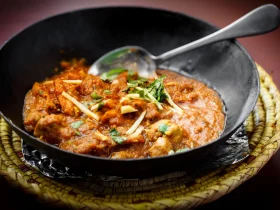

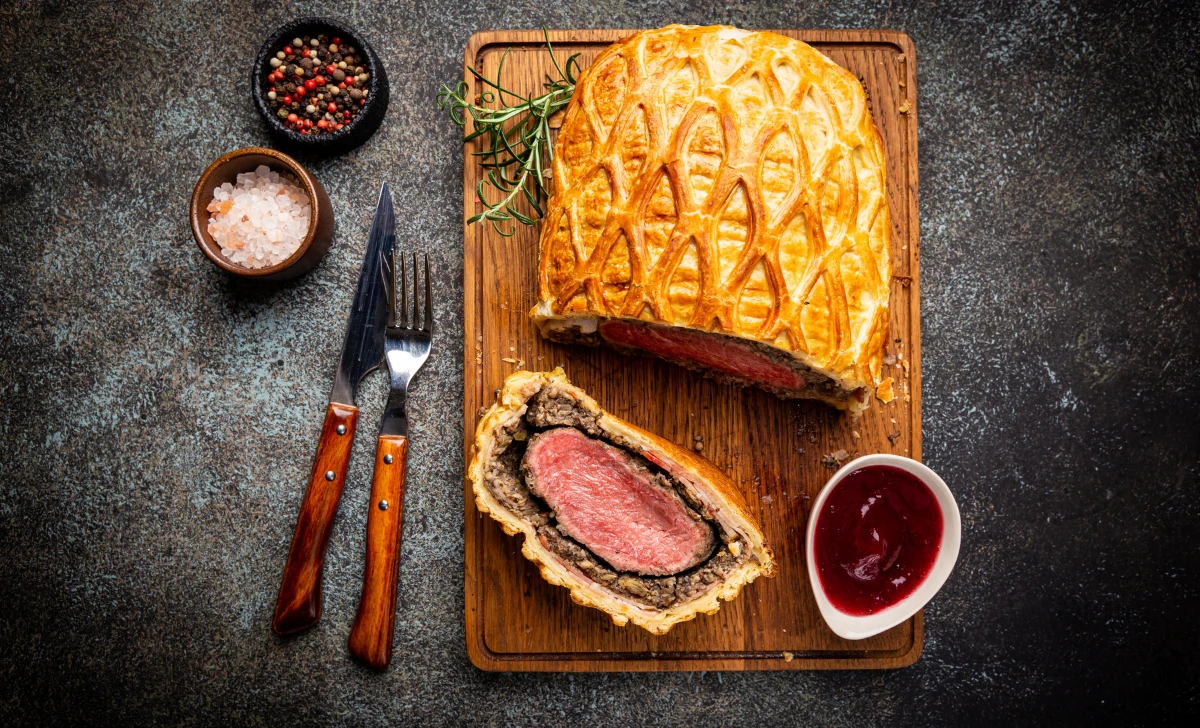

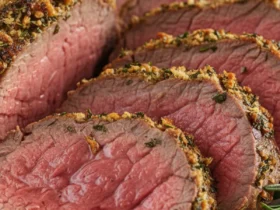
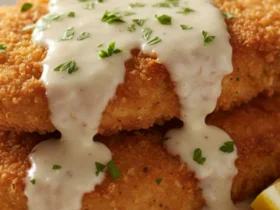

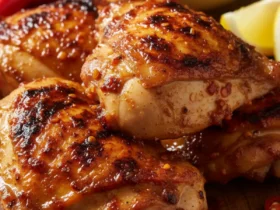
Leave a Review